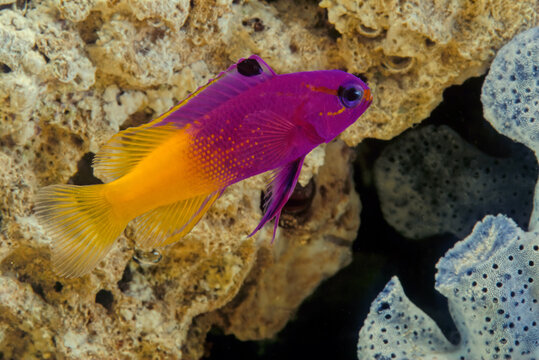ANIMAL: Royal Gramma Gramma loreto Type of Animal: Basslet Habitat: Found at depths of 3-200 ft-reefs, ledges, caves, caverns, rocks, crevices, overhangs, shelves Location(s): Found in W Atlantic & Caribbean from Florida to NE Brazil Appearance: Light purple to deep violet fish from head to mid-body which is gold to yellow all the way to tail, small black spot on front of dorsal fin, males more colorful Food/Diet: Zooplankton, crustaceans, carrion, phytoplankton, parasites off of fish skin/scales Status in Wild: Stable Conservation: Breeding in aquariums & aquaculture. Lifestyle: Groups of 1-2 males w/ 1-20 females. These fish all born female w/ largest/most dominant fish becoming male (s). If male(s) dies/leaves, most dominant female becomes male. Sometimes, multiple schools aggregate. Additional Info: Called: Male Female Young: Fry Group: School Gestation: 1-1.5 weeks Life Span: 5-6 years Body Length: Male: 2.5-3 in Female: 1.5-2 in Main predators are lionfish, eels, snappers, groupers, & trumpetfish. These fish popular in aquarium trade. They court each other by locking jaws, almost akin to jousting. Males also flare fins, arch back, & quiver body. Males build nests among rocks, leading female (s) to area to deposit 5-100 eggs. These fish act as cleaner fish, removing/eating skin parasites living on other fish. Also called Royal Fairy Basslet & Royal Gramma Basslet. They fight by interlocking mouths & clamping down on each other. These fish important in keeping other animals healthy by removing potentially dangerous parasites. These are rather shy mellow fish. These are fairly easy fish to keep & take care of. These fish are somewhat difficult to breed. Fun Fact(s): 2nd part of scientific name loreto derives from Spanish & means “little parrot,” referencing coloration. A royal gramma named Gurgle appears in 2003 movie Finding Nemo as well as 2016 sequel Finding Dory. These fish open mouths wide to ward off intruders. These fish often swim straight up-and-down or upside down, which is sometimes mistaken for illness. This makes it easier for the fish to attach to hard surfaces as well as easier for them to dart into sheltered areas. These fish tend to be relatively cheap. These fish are great jumpers.
